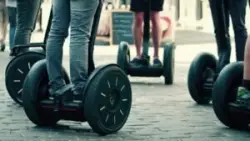
If you get hurt due to a defective Segway in Las Vegas, NV, help is available. At this point, you can go to a hospital to receive medical care for your injury. In addition, you can connect with a Las Vegas personal injury lawyer who can help you seek compensation from any parties responsible for your injury.
At H&P Law, we understand the challenges that can come up if you file a Segway accident lawsuit. With help from our Las Vegas Segway accident lawyer, you can address these challenges before they compromise your ability to get compensation from any at-fault parties. To learn more, please get in touch with us.
Why Segway Accidents Happen in Las Vegas
Driving a Segway in an urban area can pose a health risk, according to research published in the National Library of Medicine. If your electric scooter malfunctions, you can fall off of it or crash into a vehicle or pedestrian. In one of the worst-case scenarios, you can suffer a serious injury due to a Segway collision.
For your own protection, you should wear a helmet and take other precautions when you ride on a Segway. However, even when you are being careful, a Segway defect can cause your scooter to stop working correctly. The result: you can crash and get hurt, and you may need to file a product defect lawsuit.
H&P Law is a leading choice for those who want to hire an experienced Las Vegas Segway accident attorney. We can take a look at your claim and help you submit your lawsuit in alignment with Nevada’s laws. We can manage the legal aspects of your case while you concentrate on recovering from your injuries.
What to Do If You Are Involved in a Segway Accident in Las Vegas
If you are involved in a Segway collision, try to remain calm. It is important to get the care you need to recover from the incident without compromising a potential personal injury claim. If you are physically able, we recommend the following actions:
Call 911
Notify 911 about your crash, and medical personnel and police officers will come to the accident scene. Medical professionals will treat your injury and transport you to an emergency room as needed. Police officers can collect information from you and anyone else involved in your crash.
Gather Evidence
Use your smartphone to take photos and videos at the scene of your accident. Focus on capturing images of the vehicle damage and your injuries. Remember, evidence collected at the scene of your Segway crash can make a big difference if you move forward with a personal injury claim.
Contact a Segway Accident Lawyer in Las Vegas
In the days after your Segway crash, schedule a free consultation with a Segway accident attorney in Las Vegas. They can connect with medical experts for a full diagnosis. They will also help you determine if you have a valid claim for compensation.
Your lawyer can find out who is responsible for your Segway collision. If the Segway manufacturer or anyone else contributed to your crash, your lawyer may advise you to seek damages. They will make sure that your lawsuit is filed correctly and in a timely manner.

When to File a Segway Crash Lawsuit
In Nevada, the statute of limitations allows only two years from the date you suffer a personal injury to sue for damages. By consulting with a personal injury lawyer as soon as you can after your Segway collision, you can submit your claim for compensation before it becomes too late to do so.
Your attorney may recommend that you ask for non-economic and economic damages in your Segway accident lawsuit. Non-economic damages will be awarded based on your pain and suffering. Economic damages are intended to cover your medical bills, damage to your personal property, and other quantifiable losses.
In a personal injury lawsuit in Las Vegas, there is no restriction on how much money you can ask for from an at-fault party. To get damages, you must be able to show that a negligent party caused your Segway crash. If you are successful, you could be awarded compensation appropriate to your losses.
How Much Money You May Get in a Las Vegas Segway Crash Lawsuit
Every Segway accident lawsuit is different and will have a unique outcome. How much money you get in a traffic accident case versus a crash that occurs away from traffic varies. Your lawyer will look at many factors relating to your case and provide you with a personalized recommendation on how much to request in compensation.
Your lawyer works with you to calculate your Segway crash damages. They consider the short- and long-term costs associated with your collision. Your attorney files a claim in which you ask for a reasonable amount of compensation and ensures you are in a great position to secure this amount.
Once you ask for money in a Segway collision lawsuit, you and your attorney build your case. On top of this, you and your lawyer can negotiate with the defendant. This may allow you to get a settlement without having to go to trial.

How to Respond to a Segway Collision Settlement Offer
If you receive a settlement in your Las Vegas Segway crash case, you are under no obligation to accept it. However, it is generally a good idea to discuss a settlement proposal with your lawyer. This allows you and your Segway accident lawyer in Las Vegas to decide if it is in your best interests to accept the proposal and close your case.
A settlement offer can fall short of what you want. In this instance, you and your lawyer can decline the proposal and continue to prepare for your trial. There is also the option to counter the proposal and see if the defendant is willing to accept a revised version of their original agreement.
If no settlement agreement is in place before your trial, you and your attorney present your case to a judge or jury. The defendant and their lawyer do the same. Then, a judge or jury decides whether to award damages.
Partner with a Las Vegas Segway Crash Attorney
H&P Law has handled dozens of Segway collision cases to date. Our Las Vegas Segway crash lawyer is available to help you with your personal injury lawsuit. To get started, contact us today.




